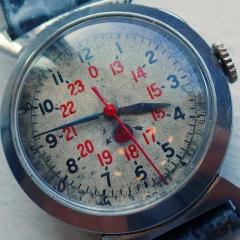-
Recently Browsing
- No registered users viewing this page.
-
Topics
-
Posts
-
25.9mm Thank you, it looks like a match !
-
Hello everybody, sorry for the late reply. Thank you all so much for your help and your tips. I got lucky and found a replacement wheel bridge for cheap which actually ended up being in decent condition. I decided not to do anything about the mainspring barrel pivot since I didn't have the right tools and the barrel didn't have much endshake anyhow. I am happy to report that the watch now runs great, I have regulated it to about +-10/s day which is fine by my standards. The timegrapher result looks decent as well, although beat error is around 0.6ms which could be better I suppose. Amplitude reaches over 230 quite consistently which I'm happy with also. My lighter fluid has also been replaced by balance spring cleaning solution and now the springs don't stick to themselves anymore - who would have thought. I'm super happy with this watch, it might not be worth a whole lot but it's awesome that I could restore it and it makes me wear it with pride. To me it's a genuinely good lucking watch, it'll be my daily driver for a while. Thanks again to everybody for their input! I couldn't have done the repair without your help. Here are some images for those interested, the bracelet isn't original but I don't really mind:
-
By nevenbekriev · Posted
Balance-hairspring system is oscillator with big Q-factor. When all in the movement is OK, the rate (frequency) is verry close to the own resonant frequency of the balance-hairspring. But in some cases, the movement (with foult) will force the resonator to work on pritty different frequency, sometimes faster, and sometimes slower. When this happens, the amplitude is always weak. So, the first thing to ask is what is the amplitude. If it is more than 180 and the hairspring doesn't touch itself and anything else, then for sure it is 'short'. If the amplitude is weak, then the first thing to do is to understand why and rectify the problem. At this time no point to check timekeeping. But, if one doubts that the hairspring is not correct, then He needs to calcullate the rate of the movement, then to 'vibrate' the balance-hairspring out of the movement and to measure the free oscillations frequency (period) with timer in order to ensure that they comply with the rate. If we have pictures, then it will be easier to tell something about that wheel. -
So much work has gone into this! Thanks again @Jon. I will go back and check my adjustments from last weekend. A few questions for you, if you don't mind. In the reset position, I can understand the problem if the gap between the hammer and the minute counter heart is too big (slide 77) but what is bad about both hammers being in contact with the cams (slide 76)? I read somewhere that Landeron recommended grease on the runner cam, but the minute counter heart should be dry. Is that so, and why? How many tads in a ligne?
-






Recommended Posts